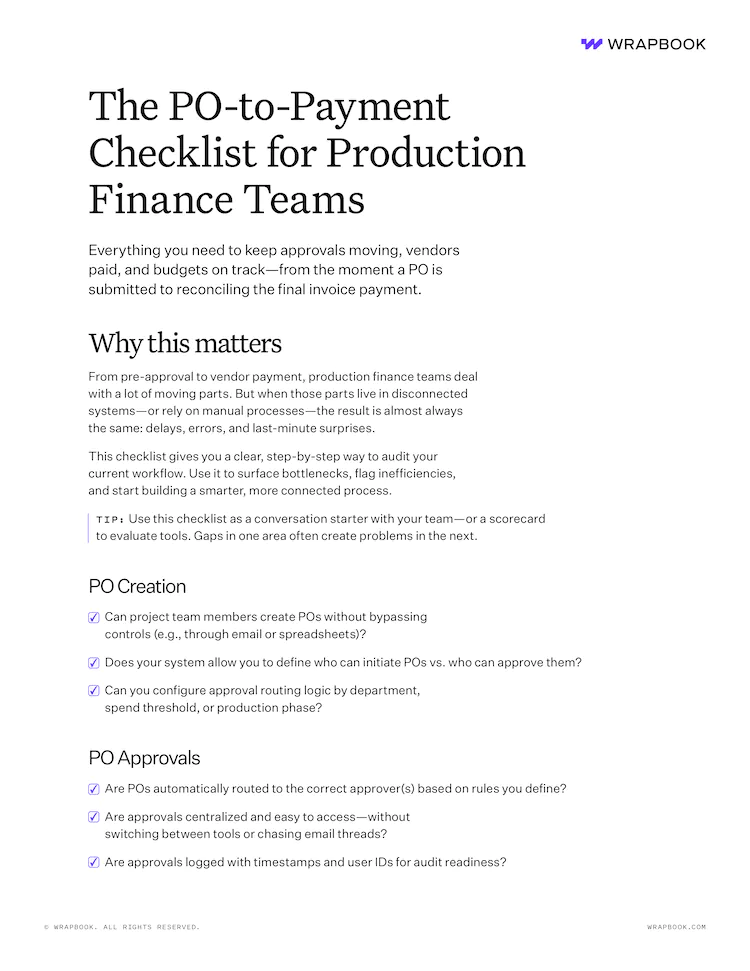

At Wrapbook, we pride ourselves on providing outstanding free resources to producers and their crews, but this post is for informational purposes only as of the date above. The content on our website is not intended to provide and should not be relied on for legal, accounting, or tax advice. You should consult with your own legal, accounting, or tax advisors to determine how this general information may apply to your specific circumstances.
Every production depends on vendors—sometimes dozens, sometimes hundreds. From camera rentals and caterers to lumber yards and post houses, each one brings new contracts, invoices, and compliance requirements.
Managing vendors isn’t just about forms and approvals. It’s about making sure everyone—crew, production managers, and accountants—works from the same playbook. Without coordination, small issues spiral: duplicate vendor entries, delayed payments, or errors in incentive filings.
That’s why the future of vendor management in production is less about paperwork and more about collaboration.
Vendor management touches nearly every department:
When each group operates in isolation, the process slows down and risks multiply. But when vendor activity lives in a shared system, everyone works from the same source of truth. Crew can enter POs directly, managers can review in context, and accountants can see the downstream compliance impact in real time.
Risk management is another area where collaboration is essential. Key checks—like verifying W-9s, validating Taxpayer Identification Numbers, gathering and validating vendor banking information—can’t be left to one person or department.
With shared systems:
Instead of reacting to problems at wrap, risk is managed continuously as part of the workflow. Just as importantly, shared visibility helps productions identify and prioritize trusted vendors—those with a proven record of compliance, reliability, and financial stability—so future projects can engage them with greater confidence.
Choosing vendors isn’t just about who can deliver quickly or at the lowest price—it’s about building a roster of partners who consistently meet production standards. A good vendor management system helps productions evaluate and select vendors based on more than just availability:
By surfacing these signals inside a collaborative system, vendor management shifts from being reactive to proactive. Productions don’t just avoid risky vendors—they strengthen a core network of trusted partners who can be re-engaged with confidence.
A collaborative vendor management system (VMS) gives production teams and accountants a single source of truth. The most valuable features include:
With this setup, vendor onboarding, approvals, and payments flow smoothly. Problems are flagged before they become costly. Wrapbook is designed with this in mind, learn more about it here.
Most vendor problems trace back to onboarding. If the right information isn’t captured upfront, accountants and coordinators are left chasing it down later. Collaborative onboarding solves this by:
With onboarding handled in a shared system, crew can move faster, and accountants can trust the data without re-checking every line.
For productions, fast payments keep vendors happy and operations moving. For accountants, speed can’t come at the cost of compliance.
A good VMS requires approval tiers that route invoices based on spend or risk. By the time a payment is released, accountants know every box is checked.
Perhaps the biggest payoff comes at wrap. With vendor activity tracked in real time, accountants can run 1099 previews throughout the year and fix discrepancies early. At year-end, the system should deliver:
Instead of a January crunch, reporting becomes a smooth close.
Vendor management in production is no longer just about chasing W-9s and reconciling POs. It’s about giving crew, UPMs, and accountants a shared system that keeps compliance airtight, payments predictable, and reporting clean across every show.
To see firsthand how Wrapbook brings vendors, productions, and accounting together, reach out for a tour of our all-in-one platform.